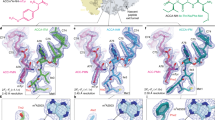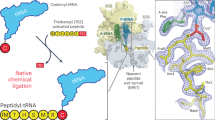Summary
The susceptibility of Thermoplasma acidophilum (an extremely acidophilic, moderately thermophilic, wall-less sulphur-oxidizing archaebacterium) to 50 ribosome-specific inhibitors of polypeptide elongation was surveyed using efficient poly(U)-and poly(UG)-directed cell-free systems and comparable reference systems derived from eubacterial (Bacillus stearothermophilus, Escherichia coli) and eukaryotic (Saccharomyces cerevisiae) species. Under optimum temperature (58° C) and ionic conditions for polypeptide synthesis Thermoplasma ribosomes are only sensitive to the 70 S/80 S ribosome-directed aminoglycoside neomycin, and to five 80 S ribosome-directed inhibitors all of which (α-sarcin, mitogillin, restrictocin, dianthin and gelonin) impair the functioning of the large (60 S) ribosomal subunit. Sensitivity of the three structurally related compounds α-sarcin, mitogillin and restrictocin and susceptibility to neomycin place Thermoplasma ribosomes between those of Sulfolobus solfataricus (only sensitive to α-sarcin) and Methanococcus vannielli (sensitive to α-sarcin, mitogillin, restrictocin and neomycin but also affected by a variety of 70 S ribosome-directed drugs). The phylogenetic significance of the greatly diversified antibiotic sensitivity spectra displayed by archaebacteria in general, as opposed to the uniform ones exhibited by eubacteria and eukaryotes, is discussed.
Similar content being viewed by others
References
Barbieri L, Stirpe F (1982) Ribosome inactivating proteins from plants: properties and possible uses. Cancer Surveys, vol I. Oxford University Press, pp 489–520
Beauclerk AAD, Hummel H, Holmes DJ, Böck A, Cundliffe E (1985) Studies on the GTPase domain of archaebacterial ribosomes. Eur J Biochem 151:245–255
Böck A, Kandler O (1985) Antibiotic sensitivity of Archaebacteria. In: Woese CR, Wolfe RS (eds) The Bacteria. A treatise on structure and function, vol VIII. Academic Press, London, pp 525–543
Böck A, Bar U, Schmid G, Hummel H (1983) Aminoglycoside sensitivity of ribosomes from the archaebacterium Methanococcus vannielii: structure-activity relationships. FEMS Microbiol Lett 20:435–438
Cammarano P, Teichner A, Londei P, Acca M, Nicolaus B, Sanz JL, Amils R (1985) Insensitivity of archaebacterial ribosomes to protein synthesis inhibitors. Evolutionary implications. EMBO J 4:811–816
Cammarano P, Teichner A, Londei P (1986) Intralineage diversity of archaebacterial ribosomes. Evidence for two physicochemically distinct ribosome classes in the third urkingdom. Syst Appl Microbiol 7:137–146
Chan YL, Endo Y, Wool IG (1983) The sequence of the nucleotides at the α-sarcin cleavage site in rat 28 S ribosomal ribonucleic acid. J Biol Chem 258:12768–12770
Elhardt D, Böck A (1982) An in vitro polypeptide synthesizing system from methanogenic bacteria. Sensitivity to antibiotics. Mol Gen Genet 188:128–134
Falasca A, Gasperi-Campani A, Abbondanza A, Barbieri L, Stirpe F (1982) Properties of the ribosome inactivating proteins gelonin, Momordica charantia inhibitor and dianthin. Biochem J 207:505–509
Fox GE, Stackenbrandt R, Hespell J, Gibson J, Maniloff J, Dyer TA, Wolfe RS, Balch WE, Tanner RS, Magrum LJ, Zablen LB, Blakemore R, Gupta R, Bonen L, Lewis BJ, Stahl DA, Luehersen KR, Chen KN, Woese CR (1980) The phylogeny of prokaryotes. Science 209:457–463
Fox GE, Luehersen KR, Woese CR (1982) Archaebacterial 5 S ribosomal RNA. Zbl Bakt Hyg I Abt Orig C3:330–354
Gesteland RF (1966) Isolation and characterization of ribonuclease I mutants of Escherichia coli. J Mol Biol 16:67–84
Hummel H, Bar U, Heller G, Böck A (1985) Antibiotic sensitivity pattern of in vitro polypeptide synthesis systems from Methanosarcina barkerii and Methanospirillum hungatei. Syst Appl Microbiol 6:125–131
Klink F (1985) Elongation factors. In: Woese CR, Wolfe RS (eds) The bacteria. A treatise on structure and function, vol VIII. Academic Press, London, pp 379–410
Londei P, Altamura S, Cammarano P, Petrucci L (1986a) Differential properties of ribosomes and of poly(U)-directed cell-free systems from sulphur-dependent archaebacteria. Eur J Biochem 157:455–462
Londei P, Sanz JL, Altamura S, Hummel H, Cammarano P, Amils R, Böck A, Wolf H (1986b) Unique antibiotic sensitivity of archaebacterial polypeptide elongation factors. J Bacteriol 167:265–271
Mans RJ, Novelli GD (1961) Measurement of incorporation of radioactive aminoacids into protein by a filter paper disk method. Arch Biochem Biophys 94:48–53
Palmer E, Wilhelm JM (1978) Mistranslation in a eukaryotic organism. Cell 13:329–334
Sanz JL, Amils R (1984) Sensitivity of thermoacidophilic archaebacteria to α-sarcin. FEBS Lett 171:63–66
Schopf JW (1979) Biostratigraphic usefulness of stromatolite precambrian microbiotas: a preliminary analysis. Precambrian Res 5:143–173
Sigmund CD, Ettayebi M, Morgan EA (1984) Antibiotic resistance mutations in 16 S and 23 S ribosomal genes of E. coli Nucleic Acids Res 12:4653–4663
Singh A, Ursic D, Davies J (1979) Phenotypic suppression and misreading in Saccharomyces cerevisiae. Nature 277:146–148
Skinner R, Cundliffe E, Schmitt FJ (1983) Site of action of ribosomal RNA methylase responsible for resistance to erythromycin and to macrolide antibiotics. J Biol Chem 258:12702–12706
Sor F, Fukuhara H (1982) Erythromycin and spiromycin resistance mutations of yeast mitochondria: nature of the rib-2 locus in the large ribosomal gene. Nucleic Acids Res 10:6571–6577
Teichner A, Londei P, Cammarano P (1986) Intralineage diversity of archaebacterial ribosomes. A dichotomy of ribosome features separates sulfur-dependent archaebacteria and Methanococcaceae from other archaebacterial taxa. J Mol Evol 23:343–353
Vazquez D (1979a) Inhibitors of protein biosynthesis. In: Kleinzeller A, Springer GF, Wittman HG (eds) Molecular biology, biochemistry and biophysics, vol 30. Springer-Verlag, Berlin, Heidelberg, New York, pp 198–201
Vazquez D (1979b) Inhibitors of protein biosynthesis. In: Kleinzeller A, Springer GF, Wittman HG (eds) Molecular biology, biochemistry and biophysics, vol 30. Springer-Verlag, Berlin, Heidelberg, New York, pp 6–14
Vazquez D, Jimenez A (1980) Antibiotics inhibitors of translation in eukaryotes. In: Chambliss G, Craven GR, Davies J, Davis K, Kahan L, Nomura M (eds) Ribosomes: structure function and genetics. University Park Press, Baltimore, pp 847–869
Wilhelm JM, Pettit S, Jessop J (1978) Aminoglycoside antibiotics and eukaryotic protein synthesis: structure-function relationships of misreading with a wheat embryo system. Biochemistry 17:1143–1148
Woese CR, Gupta R (1981) Are archaebacteria merely derived prokaryotes? Nature 289:95–96
Woese CR, Olsen GJ (1987) Archaebacterial phylogeny: perspectives on the urkingdoms. Syst Appl Microbiol 806 (in press)
Zillig W, Schnabel R, Tu J, Stetter KO (1982) The phylogeny of archaebacteria including novel anaerobic thermoacidophiles in the light of RNA polymerase structure. Naturwissenschaften 69:197–204
Zillig W, Schnabel R, Gropp F, Reiter WD (1985a) The evolution of the transcription apparatus. In: KH Schleifer, E Stackenbrandt (eds) Evolution of prokaryotes. Academic Press, London, pp 45–72
Zillig W, Schnabel R, Stetter KO (1985b) Archaebacteria and the origin of eukaryotic cytoplasm. Current Top Microbiol Immunol 114:1–18
Author information
Authors and Affiliations
Rights and permissions
About this article
Cite this article
Sanz, J.L., Altamura, S., Mazziotti, I. et al. Unique antibiotic sensitivity of an in vitro polypeptide synthesis system from the archaebacterium Thermoplasma acidophilum. Phylogenetic implications. Mol Gen Genet 207, 385–394 (1987). https://doi.org/10.1007/BF00331605
Issue Date:
DOI: https://doi.org/10.1007/BF00331605




